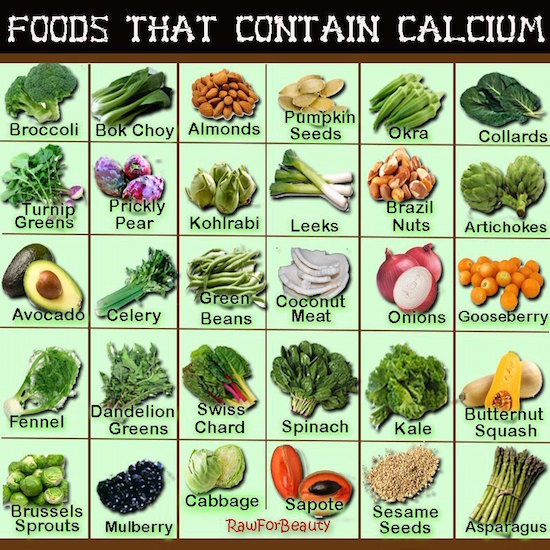What are the best non-dairy sources of this vital mineral?
By Robert Harrington
Natural Society
Calcium is not only the most abundant mineral in the body, it is also the most commonly found in the material universe. Yes, it is that ubiquitous and therefore it can be found in good measure in various food groups.
The real challenge with maintaining sufficient calcium levels lies in proper absorption, uptake and assimilation. This is where some sources of dietary calcium are far superior to others.
There are little magic formulations of “Calcium and Company” all throughout the plant kingdom. The very best of these have naturally optimized the vital proportions in a mix of calcium, magnesium, phosphorus and boron. In so doing Mother Nature has not only ensured an efficacious and bioavailable form of calcium for the human body, it also comes with an efficient (and quite natural) delivery system.
Here’s the real challenge with proper calcium utilization.
Calcium is not the easiest mineral to absorb, uptake or assimilate. It requires not only the right percentage of magnesium to be present, it is also more bioavailable when it is eaten in foods with specific enzymes, vitamins an other trace minerals. When ingested in this manner, calcium will enjoy an ever-present availability so that it is not taken from the bones or other tissues in times of great need.
Over-compensation With Calcium Supplementation
There is also the serious matter afflicting many post-menopausal Baby Boomers these days in their quest to live a long and healthy life free of osteoporosis. Many of these women have followed the doctor’s advice about adhering to a disciplined regimen of calcium supplementation. This nutraceutical approach has proven disastrous for many and here’s why.
Calcium is one of those minerals that requires certain factors to be present in order for it to be properly digested and metabolized, absorbed and assimilated.
The human body is indeed knit together with calcium; and unique ways have evolved for it to be efficiently utilized at the many times and in the many places that it is needed – sometimes desperately.
However, when certain “laws” are violated, the essential mineral calcium lies down in all the WRONG places and in all the WRONG ways.
Here are some examples: (i) Calcium will start to accumulate in the kidneys and form kidney stones,(ii) in the liver and gallbladder contributing to the formation of gallstones, (iii) in the arteries as ateriosclerosis (plaque), (iv) in arthritic joints as bone spurs, calcium deposits or malformed bones, (v) and in the vascular system of the head as calcified blood vessels in the brain.
In fact, the long term over-supplementation of calcium can contribute as a major cofactor to cardiovascular disease, stroke, high blood pressure, glaucoma, osteoarthritis, depression, fatigue, and, oh yes, even osteoporosis, among many other maladies that plague modern society.
(Source: The Health Coach)
These are just a few of the known reasons why you want to be very careful about taking too much “bottled” calcium. Yes, it can be downright dangerous. Over-compensation always has its downside risks.[1]
What are the best organic and natural sources then?
First, plant-derived calcium is superior to animal-based. Green leafy vegetables are one of the very best sources of bioavailable calcium; just make sure the greens are cooked properly with seaweed and additional rock salt so that they are sufficiently predigested (cooked real soft). The human stomach is much different than a cow’s, overcooking the greens is not a bad idea for the compromised digestive system.
Spinach, Turnip Greens, Kale, Collards, Mustard greens, Bok choy — all of these can be rotated each and every week at a minimum. Cooking the greens with well-chopped turnips, parsnips or rutabaga really adds to the mix. However, none is so tasty as collard greens and yucca … just be sure to sharpen the knife before cutting the yucca.
The other excellent sources of natural calcium include:
• White beans
• Almonds (especially Almond milk)
• Sesame seeds (especially Tahini and Sesame milk)
• Chia seeds
• Seaweed
• Broccoli
• Okra
• Butternut squash
• Oatmeal
• Tofu
• Arugula
• Watercress
• Quinoa
• Oranges
• Avocado
• Pumpkin seeds
• Figs & Prunes
• Dried fruit and nuts
• Blackstrap molasses
• Raw, Organic, Whole Milk that is drank warm for those who are not lactose intolerant, casein-sensitive or allergic to dairy products in general.
• Organic Yogurt & Kefir
• Certain Soft, Organic, Rennet-free Cheeses
Conclusion
Don’t forget or neglect your calcium-rich foods! They are that important to living a long and healthy life.
Long-term calcium supplementation ought to be considered only when absolutely necessary. The source and quality of the calcium is of critical importance; so is the exact formulation and other additives.
Too much substandard or indigestible calcium will always produce side effects: some of them will be adverse enough that you will know when to stop.
Reference
[1] OVER-COMPENSATION: Are you breaking a basic law of healing?


